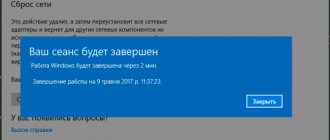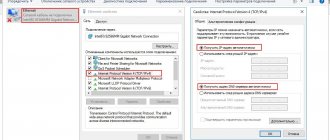Windows 10 comes with a variety of command line tools that help you manage network configurations and troubleshoot problems.
This article will describe eight such tools. In Windows 10, you can easily connect to the network and the Internet using a wired or wireless connection. However, sometimes you need to manage settings manually or troubleshoot connection problems. This is where built-in command line tools can come in handy.
For almost any problem, Windows 10 offers a command line tool. For example, ipconfig and ping are some of the main tools for viewing network settings and troubleshooting connection problems. If you're dealing with a routing problem, the route command can show the current routing table to investigate and identify problems, and the nslookup tool can help diagnose DNS problems.
There are also tools such as arp to troubleshoot switching problems and determine the MAC address from the IP address. The netstat command line tool allows you to view statistics for all connections. You can use the netsh tool to display and change many aspects of your network configuration, such as checking the current configuration, resetting settings, managing Wi-Fi and Ethernet settings, enabling or disabling the firewall, and much more.
This Windows 10 guide will cover eight command line tools that will help you manage and fix network problems on your computer and network.
IPConfig
In Windows 10, ipconfig (Internet Protocol Configuration) is one of the most common network tools that allows you to query and display the current TCP/IP (Transmission Control Protocol/Internet Protocol) network configuration.
The command also contains parameters to perform various actions, such as updating Dynamic Host Configuration Protocol (DHCP) and Domain Name System (DNS) settings. Show network configuration
- Click on the "Start" button.
- Search for cmd and right-click on “Run as administrator.”
- Type the command to view TCP/IP network configuration information and press enter: ipconfig
Tip:
On the command line, you can use the cls command to clear the screen after you no longer need the information from ipconfig. - Type the following command to view all TCP/IP network configuration and press enter: ipconfig /all
After completing these steps, you will have an overview of the entire TCP/IP configuration on your computer.
Updating network settings
To reset and update your network configuration using the command line, follow these steps:
- Click on the "Start" button.
- Search for cmd and right-click on “Run as administrator.”
- Type the command to remove the current network configuration and press enter: ipconfig /release
- Type the command to change the network configuration and press enter: ipconfig /renew
After completing these steps, the first command will clear the current configuration, and the second will download new settings from the DHCP server to resolve connection problems. If the dynamically assigned settings on the server have not expired, you can often get the previous IP address on the device.
Updating DNS Settings
To clear and restore current DNS cache entries in Windows 10, follow these steps:
- Click on the "Start" button.
- Search for cmd and right-click on “Run as administrator.”
- Type the command to flush the system DNS cache on the device and press enter: ipconfig /flushdns
After completing these steps, the entries stored in the Windows 10 DNS cache will be deleted and updated. Typically, this command is needed when you are unable to connect to another computer or website using the host or domain name due to outdated information in the local cache.
Disabling protection from users without passwords
Not all users create a password to log into the system, which is why they cannot log into a network computer to gain access to directories. In this case, you can set a password for the profile or change the security setting. If everything is clear with the first method, then the security parameters are set as follows:
- Launch the application "Local Security Policy", having found it through "Start".
- Expand "Local Politicians" and click on the folder "Security Settings".
- You are interested in the line "Accounts: Allow empty passwords only for console login".
- Disable this setting to remove restrictions. After this, those users who do not have local account protection will be able to connect to your PC.
If, after restarting your computer, you find that the setting is lost again, make sure that the current account has administrator rights. Accordingly, you need to change the setting for using empty passwords on other PCs on the network if you want to connect to them without having a security key.
Ping
Ping is another important networking tool. It allows you to send ICMP (Internet Control Message Protocol) echo request messages to check the IP connection with other devices, be it another computer on the local network or an Internet service.
Checking the device connection
To test your network connection using the ping command, follow these steps:
- Click on the "Start" button.
- Search for cmd and right-click on “Run as administrator.”
- Type the command to send an ICMP echo request to test the connection and press enter: ping IP-OR-DOMAIN
In the command, replace IP-OR-DOMAIN with the actual IP address or domain name of the computer or service you want to test.
For example, the following command tests communication between the local device and the router: ping 10.1.4.1Advice:
if you use the -a option (for example, ping -a 10.1.4.1), the command resolves the address to a hostname.
- Not necessary. Type a command to test the local computer's network stack and press enter: ping 127.0.0.1 or ping loopback
Note:127.0.0.1 is a well-known address called the loopback address. When you run the command, if you get a response, it means the network stack in Windows 10 is up and running. This is the same as pinging a device using its own network address.
After completing these steps, four successful echo replies are expected to be received from the destination.
This means that the device can communicate with the remote host. If the request times out, the problem could be caused by a variety of reasons. If you are experiencing connectivity issues, start checking your local computer to ensure that the network stack is working. Then check your connection to your router to make sure the problem is not with your local network. Then ping the website to see if there is a problem with your internet connection or the remote host.
If a remote device or service blocks ICMP, the ping command will always time out.
Diagnose packet loss activity
The ping command includes a number of parameters that can be accessed using the ping /? command.
One of these options is the ability to set the time when the tool will run. This can help in checking for lost packets when troubleshooting connection problems. To run the ping command at a specific time, do the following:
- Click on the "Start" button.
- Search for cmd and right-click on “Run as administrator.”
- Type the command to ping until it stops and press enter: ping IP-OR-DOMAIN -t
In the command, replace IP-OR-DOMAIN with the actual IP address or domain name of the computer or service you want to test.For example, this command tests connectivity between the local device and the router for 60 seconds: ping 10.1.4.1 -t
- Use the keyboard shortcut Control + C to stop pinging.
After completing these steps, you will be able to see successful and failed requests. This may give you tips on how to continue troubleshooting and resolving connection issues. On a local network, administrators typically use the ping command to find out when a service has stopped working. Additionally, this tool can be used as a quick way to check when the server is running again when restarting the server remotely.
Connections using several “white” IP addresses. Setting up local network access.
4.1. Connections using only “white” IP addresses.
In Fig. Figure 5 shows the simplest (for a network client) communication scheme using only “white” IP addresses.
Rice. 5
However, providers are extremely reluctant to agree to it, since this scheme requires that ALL devices in the client’s network have “white” addresses, which leads to their uneconomical use. In addition, the provider's router has to handle the routing of all IP packets transmitted/received on the Internet. The use of this scheme is permissible in cases where the network client expects to connect a small number of computers (from 2 to 13), and some of them are supposed to be used as servers.
Tracert
Windows 10 also includes tracert (Trace Route).
It is a diagnostic tool to determine the network path to a destination using a series of ICMP echo requests. However, unlike the ping command, each request includes a TTL (time to live) value that is incremented by one each time, allowing you to display a list of the route taken and the duration. To trace a route to a destination using the command line, follow these steps:
- Click on the "Start" button.
- Search for cmd and right-click on “Run as administrator.”
- Type the command to understand the path to the destination and press enter: tracert IP-OR-DOMAIN
In the command, replace IP-OR-DOMAIN with the actual IP address or domain name of the destination you want to troubleshoot.
For example, this command allows you to view the path that packets take to reach Google.com: tracert google.com - Not necessary. Type the commands to configure the number of hops to the destination and press enter: tracert -h HOP-COUNT IP-OR-DOMAIN
In the command, replace IP-OR-DOMAIN with the actual IP address or domain name of the destination you want to troubleshoot, and HOP-COUNT with the number of hops you want to track.
For example, the following command sets a limit of five hops (nodes) to the destination: tracert -h 5 google.com
After completing these steps, you will know if your destination is accessible or if there is a network problem along the way. Like the ping tool, tracert includes several options that can be viewed using the tracert /? command. team.
Opening access to the folder via the command line
Probably the fastest method of creating a network partition is through the command line in Windows 7 and 10.
To do this we do the following:
- Open “Start/All Programs/Accessories/Command Prompt” or write the command “cmd” in the search bar.
- In the console, enter the command: “net share files=drive letter:\folder name.” In our case, this is “net share files=d:\Business Documents” (without quotes).
NSLookup
The nslookup (name server lookup) tool can provide valuable information for troubleshooting DNS-related problems.
The tool includes interactive and non-interactive modes. Most often, you will use non-interactive mode, which means you will enter a complete command to get the information you need. You can use this command to display the default DNS name and address of the local device, determine the domain name of the IP address, or name servers for a specific host.
To get started with nslookup on Windows 10, follow these steps:
- Click on the "Start" button.
- Search for cmd and right-click on “Run as administrator.”
- Type the command to lookup the local DNS name and address, press enter: nslookup
Note:
This command is also used to open nslookup interactive mode. - Confirm your current DNS information.
- Type the following command to exit interactive mode and press enter: exit
- Type a command to determine the name and address of a specific server, press enter: nslookup IP-ADDRESS
In the command, replace IP-ADDRESS with the address of the remote device.
For example, this command looks for the IP address 172.217.165.142: nslookup 172.217.165.142 - Type the command to determine the address of a specific server and press enter: nslookup DOMAIN-NAME
In the command, replace DOMAIN-NAME with the address of the remote device.
For example, this command looks up the IP address of Google.com: nslookup google.com
After completing these steps, depending on the command, you will know whether the device has a DNS resolver and an IP address or domain, and vice versa, a remote host.
NetStat
The netstat tool displays statistics for all network connections.
This allows you to see open and connected ports to monitor and troubleshoot network issues for Windows 10 and apps. When using the netstat tool, you can get a list of active network connections and listening ports. You can view network adapter and protocol statistics. You can display the current routing table and more.
To get started with netstat:
- Click on the "Start" button.
- Search for cmd and right-click on “Run as administrator.”
- Type the command to display all active TCP connections and press enter: netstat
- Not necessary. Type a command to display active connections, showing the numeric IP address and port number instead of trying to resolve the names, and press enter: netstat -n
- Not necessary. Enter commands to update information after a certain period of time and press enter: netstat -n INTERVAL
In the command, remember to replace INTERVAL with the number of seconds after which the information should be redisplayed.In this example, the requested command is updated every five seconds: netstat -n 5
Note:
When using interval, you can terminate the command using the Ctrl+C keyboard shortcut in the console.
Once the command is run, it will display a list of all active connections in four columns, including: • Proto: Displays the connection protocol, including TCP or UDP. • Local Address: Displays the device's IP address followed by a semicolon with the connection port number. A double semicolon inside parentheses indicates a local IPv6 address. The address "0.0.0.0" also refers to the local address. • External Address: Shows the IP address (or fully qualified domain name) of the remote computer with the port number after the port name and a semicolon (for example, https, http, microsoft-ds, wsd). • Status: shows whether the connection is active (established), whether the port was closed (time_wait), or the program did not close the port (close_wait). Other available statuses include include, closed, fin_wait_1, fin_wait_2, last_ack, listen, syn_received, syn_send, and timed_wait.
ARP
Windows 10 maintains an arp (address resolution protocol) table, which stores IP entries in the Media Access Control (MAC) that the system resolves.
The arp tool allows you to view the entire table, modify entries, and use it to determine the MAC address of a remote computer. Typically you don't need to worry about MAC addresses, but there are scenarios where this information can come in handy. For example, when troubleshooting network problems at the data link (switching) level or when restricting access or filtering content through the network for certain devices.
To get started with arp on Windows 10, follow these steps:
- Click on the "Start" button.
- Search for cmd and right-click on “Run as administrator.”
- Type the following command to view the current arp table cache in Windows 10 and press enter: `arp -a'
4. Type commands to determine the MAC address of the remote device and press enter: arp -a IP
In the command, replace IP with the destination address.
For example, this command shows the physical address of the destination 10.1.4.113: arp -a 10.1.4.108 - Confirm the MAC address (physical) of the remote device.
After completing these steps, you will be able to view the entire arp table and MAC address of a specific IP address. If you want to know all the available options, use the arp /? to display a list of all parameters with descriptions.
Route
The Routing Tool displays a routing table that allows Windows 10 to understand the network and communicate with other devices and services.
The tool also offers some options to modify and clean up the table if necessary. As with the arp tool, there is usually no need to worry about the routing table. Still, this command line tool comes in handy when troubleshooting problems.
To view or clear the routing table in Windows 10, follow these steps:
- Click on the "Start" button.
- Search for cmd and right-click on “Run as administrator.”
- Type the command to view the routing table in Windows 10 and press enter: route print
- Confirm the routing table information.
- Not necessary. Type the command to clear the routing table and press enter: route -f
Note:
When running this command, the device will lose connectivity to the network because the system no longer understands the network topology.
After running the command, reboot your computer to allow the network stack to rebuild the routing table.
There is usually no need to clear the table unless you have changed some records and you need to reset the table. After completing these steps, you will understand what a routing table is and how to clear the information.
You can also use route /? to view a list of available options, including options to change network metrics, specify a gateway, add a new route, and more. However, it is generally not recommended to change these settings unless you understand how the network works.
We open access to the section through “Computer” and “This Computer”
A network folder in Windows 7 and 10 can be created in simpler ways. Now we will do this directly in the “Computer” and “This Computer” menus.
On the Seven it looks like this:
- Open “Computer”, find the target partition on the hard drive, select it and click the “Sharing/Specific Users” button on the menu bar.
- In the list at the top, select “Everyone”, set the permission to “Read and Write” and agree to the changes using the “Sharing” button.
- In the tenth version of Windows it looks a little different. After selecting the folder, click on “Share” and select “Individuals”.
Oh and we agree with the changes made.
Netsh
In Windows 10, netsh (Network Shell) is a legacy command line tool that allows you to display and change almost any network configuration.
For example, you can use this tool to view your current network configuration, manage your wireless connections, reset your network stack to fix common problems, enable or disable your firewall, and more. To get started with the netsh command line tool, follow these steps:
- Click on the "Start" button.
- Search for cmd and right-click on “Run as administrator.”
- Type a command to view a list of available commands (contexts) and press enter: netsh /?
Type the following command to view a list of available subcommands (subcontexts) for a particular option and press enter: netsh CONTEXT-COMMAND
In the command, change CONTEXT-COMMAND to a command that contains additional options.For example, this command shows the commands available to manage a firewall using netsh: netsh advfirewall /?
Once you've completed these steps, you'll understand how to navigate the netsh contexts and subcontexts command to manage network settings.
Resetting the system network stack
To reset the network stack to resolve common connectivity issues, follow these steps:
- Click on the "Start" button.
- Search for cmd and right-click on “Run as administrator.”
- Type the following command to reset the winsock stack and press enter: netsh winsock reset
- Restart your computer.
After completing these steps, the winsock configuration will be reset, which may solve network and internet connection problems.
Export and import network configuration
To export network configuration using netsh on Windows 10, follow these steps:
- Click on the "Start" button.
- Search for cmd and right-click on “Run as administrator.”
- Type the command to import the current configuration for all network adapters and press enter: netsh -c interface dump>PATH\TO\EXPORTED.txt
In the command, replace PATH\TO\EXPORTED.txt with the path and file name to store the configuration.For example, the following command exports the settings to the netshconfig.txt file: netsh -c interface dump>c:\netshconfig.txt
After completing these steps, you can open the file in any text editor to view the exported configuration.
Importing network configuration
To import network configuration settings using netsh, follow these steps:
- Click on the "Start" button.
- Search for cmd and right-click on “Run as administrator.”
- Type the command to import the network configuration and press enter: netsh -c interface dump>PATH\TO\IMPORTED.txt
In the command, replace PATH\TO\EXPORTED.txt with the path and name of the configuration file.
For example, the following command imports settings from the netshconfig.txt file: netsh -fc:\netshconfig.txt
Once these steps are completed, the new network configuration will be imported and applied to Windows 10.
Turn the firewall on or off
To enable Windows 10 firewall using netsh, follow these steps:
- Click on the "Start" button.
- Search for cmd and right-click on “Run as administrator.”
- Type the command to enable the default firewall and press enter: netsh advfirewall set currentprofile state on
After completing these steps, Windows Defender Firewall will be enabled on your device.
Disabling the firewall
- Click on the "Start" button.
- Search for cmd and right-click on “Run as administrator.”
- Type the command to turn off the default firewall and press enter: netsh advfirewall set currentprofile state off
After completing these steps, Windows Defender Firewall on your device will be turned off.
Windows 10 has many tools you can use to change settings and troubleshoot network problems using the Command Prompt, PowerShell, and graphical applications. This guide only covers how to help you work with the most common command line tools.
Enable sharing in Windows 11
I spent a lot of time trying to figure out if Microsoft had added features to configure sharing in Settings . If in the “ten” there was at least a button in this menu that launched the required “Control Panel” window, the new version of the system does not have it, so enabling sharing is still not carried out in the most convenient way - through a section in the “Control Panel”.
- Open menu "Start" and through the search you will find "Control Panel", then launch this application.
- In it you are interested in the section with the name "Network and Sharing Center".
- In the left panel, click on the link "Change advanced sharing settings".
- A list of settings for the current profile (that is, the type of network you are connected to) will automatically open. All that remains is to enable network discovery and share files and printers, which is done by checking the boxes next to the appropriate items.
- If necessary, expand other profiles and make the same settings for them. They are the same for both a private network and a guest or public network.
Please note that you must perform these actions on all computers on the network, enabling network discovery and granting access to folders. Be sure to reboot them, then move on to the next section of the article.











